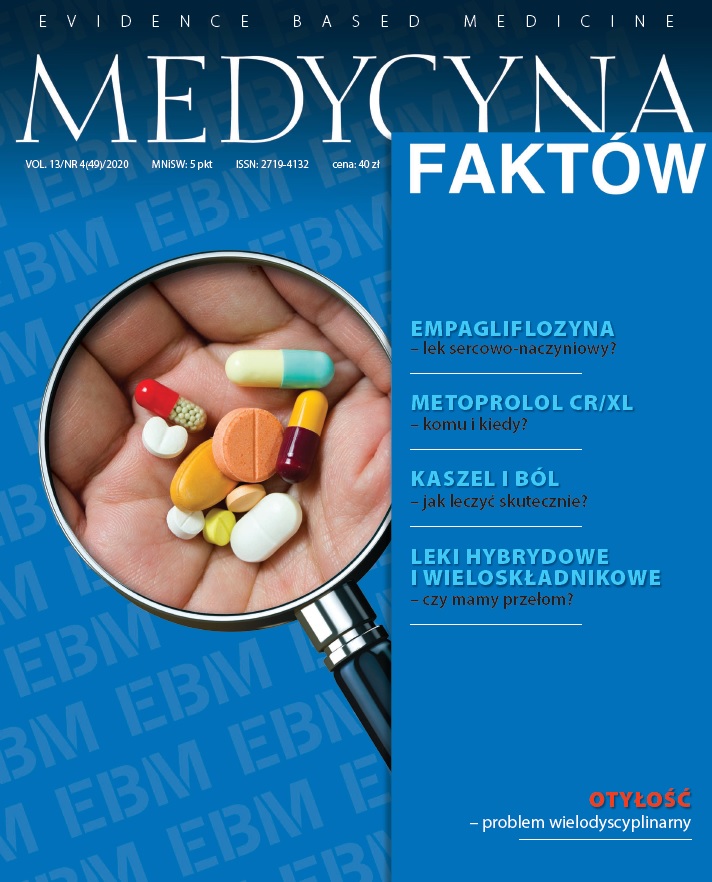Długoterminowe stosowanie mirabegronu u pacjentów leczonych z powodu nadaktywnego pęcherza moczowego Artykuł przeglądowy
##plugins.themes.bootstrap3.article.main##
Abstrakt
Nadaktywny pęcherz (OAB, overactive bladder) jest definiowany przez International Continence Society (ICS) jako zespół objawów, na który składają się parcia naglące z towarzyszącym częstomoczem dziennym i/lub nocnym, przy braku potwierdzonej infekcji lub jakiejkolwiek innej patologii, a wraz z parciami naglącymi może występować nietrzymanie moczu. Farmakoterapia z zastosowaniem leków antymuskarynowych charakteryzuje się wysoką skutecznością, jednak ponad 60% chorych rezygnuje z kontynuacji leczenia. Wprowadzenie mirabegronu, agonisty receptora ?3-adrenergicznego (?3-AR), stało się oczekiwaną opcją farmakoterapii w nieinwazyjnym leczeniu pęcherza nadaktywnego. Z dostępnych badań wynika, że długoterminowe leczenie mirabegronem w dawce 50 mg u pacjentów z OAB wiąże się ze statystycznie istotnym zmniejszeniem nasilenia objawów. Dane z badań klinicznych wskazują, że mirabegron zapewnia skuteczność podobną do leków antymuskarynowych, ale z lepszym profilem tolerancji.
##plugins.themes.bootstrap3.article.details##
Copyright © by Medical Education. All rights reserved.
Bibliografia
2. Drake MJ. Do we need a new definition of the overactive bladder syndrome? ICI-RS 2013. Neurourol Urodyn. 2014; 33(5): 622-4.
3. Chapple CR, Dvorak V, Radziszewski P et al. A phase II dose-ranging study of mirabegron in patients with overactive bladder. Int Urogynecol J. 2013; 24(9): 1447-58.
4. Lucas MG, Bosch RJL, Burkhard FC et al. EAU Guidelines on Assessment and Nonsurgical Management of Urinary Incontinence. Eur Urol. 2012; 62(6): 1130-42.
5. Abrams P, Andersson KE. Muscarinic receptor antagonists for overactive bladder. BJU Int. 2007; 100(5): 987-1006.
6. Apostolidis A. Antimuscarinics in the treatment of OAB: is there a first-line and a second-line choice? Curr Drug Targets. 2015; 16(11): 1187-97.
7. Maman K, Aballea S, Nazir J et al. Comparative efficacy and safety of medical treatments for the management of overactive bladder: a systematic literature review and mixed treatment comparison. Eur Urol. 2014; 65(4): 755-65.
8. Palmer CJ, Choi JM. Pathophysiology of overactive bladder: current understanding. Curr Bladder Dysfunct Rep. 2017; 12(1): 74-9.
9. Moro C, Tajouri L, Chess-Williams R. Adrenoceptor function and expression in bladder urothelium and lamina propria. Urology. 2013; 81(1): 211.e1-7.
10. Murakami S, Chapple CR, Akino H et al. The role of the urothelium in mediating bladder responses to isoprenaline. BJU Int. 2007; 99(3): 669-73.
11. Lee J, Moy S, Meijer J et al. Role of cytochrome p450 isoenzymes 3A and 2D6 in the in vivo metabolism of mirabegron, a ?3-adrenoceptor agonist. Clin Drug Invest. 2013; 33(6): 429-40.
12. Dickinson J, Lewand M, Sawamoto T et al. Effect of renal or hepatic impairment on the pharmacokinetics of mirabegron. Clin Drug Invest. 2013; 33(1): 11-23.
13. Chapple CR, Kaplan SA, Mitcheson D et al. Randomized double-blind, active-controlled phase 3 study to assess 12-month safety and efficacy of mirabegron, a ?3-adrenoceptor agonist, in overactive bladder. Eur Urol. 2013; 63(2): 296-305.
14. Chapple C, Amarenco G, López Aramburu MA et al. A proof-of-concept study: mirabegron, a new therapy for overactive bladder. Neurourol Urodyn. 2013; 32(8): 1116-22.
15. Nitti VW, Rosenberg S, Mitcheson DH et al. Urodynamics and safety of the ?3-adrenoceptor agonist mirabegron in males with lower urinary tract symptoms and bladder outlet obstruction. J Urol. 2013; 190(4): 1320-7.
16. Nitti VW, Khullar V, van Kerrebroeck P et al. Mirabegron for the treatment of overactive bladder: a prespecified pooled efficacy analysis and pooled safety analysis of three randomised, double-blind, placebo-controlled, phase III studies. Int J Clin Pract. 2013; 67(7): 619-32.
17. Novack GD, Lewis RA, Vogel R et al. Randomized, double-masked, placebo-controlled study to assess the ocular safety of mirabegron in healthy volunteers. J Ocul Pharmacol Ther. 2013; 29(7): 674-80.
18. Abrams P, Artibani W, Gajewski JB et al. Assessment of treatment outcomes in patients with overactive bladder: importance of objective and subjective measures. Urology. 2006; 68(2 suppl): 17-28.
19. Foley S, Choudhury N, Huang M et al. Quality of life in patients aged 65 years and older with overactive bladder treated with mirabegron across eight European countries: Secondary analysis of BELIEVE. Int J Urol. 2019; 26(9): 890-6.
20. Gray SL, Anderson ML, Dublin S et al. Cumulative use of strong anticholinergics and incident dementia: a prospective cohort study. JAMA Intern Med. 2015; 175(3): 401-7.
21. Chapple CR, Nazir J, Hakimi Z et al. Persistence and adherence with mirabegron versus antimuscarinic agents in patients with overactive bladder: a retrospective observational study in UK clinical practice. Eur Urol. 2017; 72(3): 389-99.
22. Yeowell G, Smith P, Nazir J et al. Real-world persistence and adherence to oral antimuscarinics and mirabegron in patients with overactive bladder (OAB): a systematic literature review. BMJ Open. 2018; 8(11): e021889.
23. Wagg A, Franks B, Ramos B et al. Persistence and adherence with the new beta-3 receptor agonist, mirabegron, versus antimuscarinics in overactive bladder: early experience in Canada. Can Urol Assoc J. 2015; 9(9-19): 343-50.
24. Yamanishi Y, Yamanishi T, Tajima H et al. Mirabegron or tolterodine for the treatment of overactive bladder in Japan: which drug is more cos-effective as the first-line treatment? Int J Urol. 2018; 25(10): 863-70.
25. Murray B, Hessami SH, Gultyaev D et al. Cost effectiveness of overactive bladder treatments: from the US payer perspective. J Comp Eff Res. 2019; 8(1): 61-71.
26. Castro-Diaz D, Chapple CR, Hakimi Z et al. The effect of mirabegron on patient-related out- comes in patients with overactive bladder: the results of post hoc correlation and responder analysis using pooled data from three randomized phase III trials. Qual Life Res. 2015; 24(7): 1719-27.
